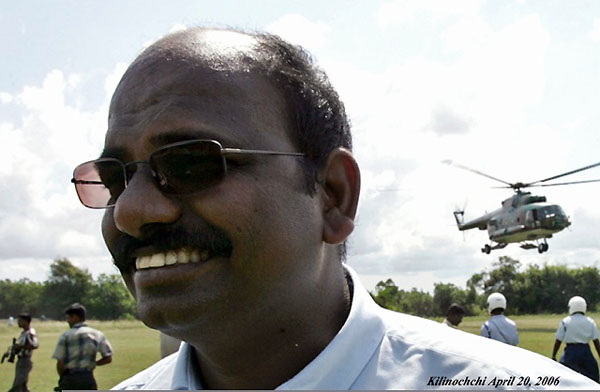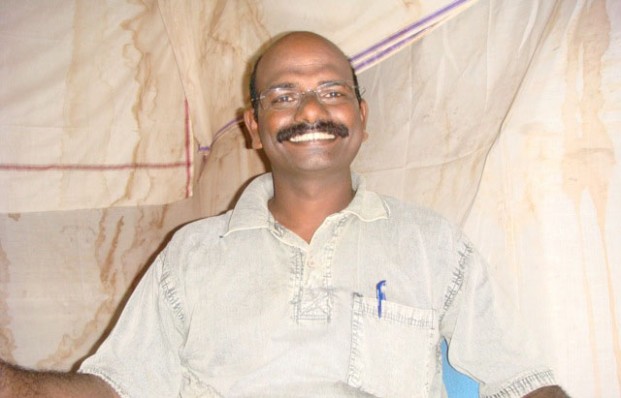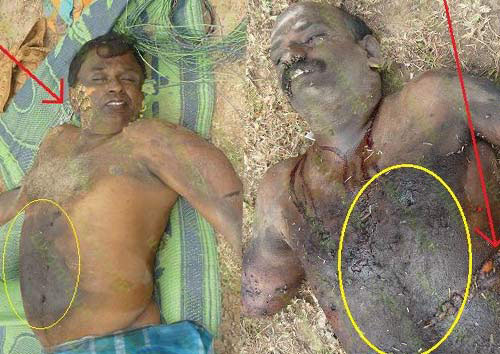by Francis Harrison, ‘Asian Correspondent,’ UK, March 4, 2013
In May 2009, as the civil war was drawing to a close, the Sri Lankan army executed influential Tamil leaders even though they had already surrendered. Frances Harrison spoke to two Tamil fighters who witnessed the incident and revealed the atrocity to the world
The stocky Tamil man twisted himself nervously inside his thin black anorak, ill suited to one of the iciest days of winter, as he explained how he turned informer, betraying the very man he was supposed to protect, in order to save his own life. We endured the bone-chilling cold sitting outdoors on a deserted verandah sipping coffee in a café in Victoria Station, interrupted occasionally by the peremptory platform announcements. Indoors it was warm but there were too many people who might be listening; after all, we were talking about summary execution.
Kumaran, who doesn’t want to give his real name out of fear, had once been a Tamil Tiger rebel fighting for a separate homeland in north-eastern Sri Lanka. Now a refugee in a land where he doesn’t speak the language, he still exudes the confidence that might come from having once carried a gun. This was a man trusted enough to be the bodyguard of the political leaders of the Tamil Tigers.
In the chaos of the last weeks of the civil war in 2009, Kumaran was badly injured when a cluster bomb landed close to him. Medicine and even bandages were running out and the handful of doctors left were amputating limbs with butcher’s knives and no anesthetic. Without medical treatment Kumaran had no chance of recovery. He decided to make a run for it across the frontline – first throwing away the cyanide capsule that’s standard issue for Tamil Tigers rebels to swallow in case of capture.
Surrender
Telling the story of his escape, Kumaran is tellingly short on details. Tamil Tiger rebels were supposed to fight to the death – surrender was considered a cowardly act of self-preservation.
As soon as he crossed the frontline, two former rebels turned traitor immediately spotted Kumaran and pointed him out to the army.
“They had no choice if they wanted to live,” Kumaran said with sympathy. “They only informed on people who were very obviously fighters and would be noticed anyway,” he said, explaining why he too turned informer once in the hands of the enemy. The screams of his comrades being tortured in the detention centre were enough to turn him.
I was sitting in a deserted portion of Victoria Station across a table from Kumaran and a second Tamil man who used to teach maths in another life. They are the first eyewitnesses to come forward to speak about what’s known as “the white flag incident”. This euphemistically refers to the murder of a group of Tamil Tiger political wing leaders after they had negotiated a surrender on the last day of the war.
Frantic
Even the Sri Lankan President knew that the group planned to surrender – they’d sent frantic messages through everyone they could think of – the UN, the Red Cross, Norwegian diplomats, Sunday Times journalist Marie Colvin, intermediaries in Europe and a Tamil member of parliament. All the indications from top officials in the Sri Lankan government were reassuring – that the surrender would indeed be accepted in accordance with the Geneva Convention.
One of those surrendering was Pulidevan, whom I’d known more than a decade ago when he was a peace negotiator for the Tamil Tigers and I was the BBC correspondent based in Sri Lanka. Puli – as his friends called him – loped about in that slightly ungainly apologetic way tall men sometimes do in places where being short is the norm. He loved nothing more than to sit down on his office sofa and chew over the current political situation at rapid speed like a man starved of discussion. When I left Sri Lanka for another posting he resolutely stayed in touch.

Pulidevan was ready for the Tamil surrender.
By the final months of the Sri Lankan civil war in 2009 Puli started coming online almost daily to chat. It was a desperate cry for help. Sometimes we discussed politics, battlefield strategy and the uncertain future, but mostly he wanted to escape the daily reality of severed body parts and screaming mothers. It’s a strange thing but if you talk to someone continuously through months of war you start rooting for their survival even though rationally the chances are slim. We even discussed the fact that if he was caught trying to escape or surrender he’d likely be killed.
For the last four years I’ve been trying to piece together what really happened to Puli and the others. This meeting in Victoria Station was a huge breakthrough. It was surreal to be discussing layer upon layer of treachery on the battlefields of northern Sri Lanka amid the mundane hustle and bustle of commuters in the middle of London.
Soon we’re drawing an untidy map on my notebook to mark the frontline and the bridge across the lagoon over which tens of thousands of emaciated civilians escaped at the end – leaving behind them billowing black smoke and pounding shells. Kumaran shows me where he was positioned by the Sri Lankan military – behind an earthen embankment near a tree. The army wanted him to confirm the identity of the Tiger political leaders crossing over. Who better than their former bodyguard? It never crossed Kumaran’s mind that he was endangering them because this was clearly a well-planned and organised surrender. Senior Sri Lankan military officials were everywhere with bodyguards and walkie-talkies.
White flag
The first batch to cross the frontline carrying a white flag included the wife of the Tiger political leader. She was not a Tamil but Sinhalese – the same ethnic group as the soldiers. As they approached she was urgently screaming something in their language that Kumaran couldn’t understand – probably urging the soldiers to hold their fire. He watched the Tiger leaders cross over. They were received by the soldiers who escorted them across the bridge, moving towards a cluster of vehicles in the distance. More groups of Tigers walked past him at intervals and surrendered.
Once it was over Kumaran waited around for an hour or so before being driven away by the military. After a while Kumaran, sitting in the back of a pick-up truck, noticed a crowd of soldiers gathered alongside some open ground next to the road. They were taking pictures on their mobile phones of corpses laid out there. As they drove past Kumaran was horrified to see Puli and his boss, Nadesan, the political leader, lying there dead, their shirts stripped off their torsos.
Kumaran quickly understood that as a witness to this crime he was even more in danger than before. “I thought if they can do this to them, what can they do to me,” he recalled, his eyes filling with tears, “one of the hardest things in the hours and days ahead was to keep this knowledge inside me and not speak of it to anyone”.

The last known photo of Puli before his death.
Kumaran had no idea that there were other Tamil witnesses to the surrender who might also make it abroad one day. Sitting next to him is Sharmilan, who once taught maths to rows of neatly dressed school children in blue and white uniforms in the area of northern Sri Lanka under the control of the Tigers. He won’t tell me his real name or which school he worked in lest it identify him and endanger his relatives in Sri Lanka.
Sipping coffees to keep warm and keeping a careful eye on who was coming and going in the cafe, the two men are cordial but not especially chummy with each other. There’s awkward laughter all round when I ask Sharmilan if he was forcibly recruited by the Tigers. He cited the rule that every family had to give one fighter to the rebels – and goes on to explain how after only a month’s training he was press ganged into digging bunkers and disposing of dead bodies in the last year of the war.
The night before the top political leaders of the Tamil Tiger surrendered, Sharmilan had decided to make a run for it with a large group of civilians. It was still dark so the army held them in a destroyed building on the frontline waiting for dawn.
Escort
Sharmilan was surprised when he looked through the window and saw the Tiger political leaders walk by with white flags; he knew surrender was a taboo for an organization that glorified martyrdom. Sharmilan observed the soldiers receive the first group of about 15 people and frisk them for weapons before escorting them over a bridge until they disappeared from sight. In the distance he spotted not just military vehicles but also big white jeeps of the kind used by international aid organisations. Sharmilan estimates there were about five hundred soldiers in the area. He’s adamant all the Tiger political leaders surrendered successfully.
This is of course not what the Sri Lankan military says. It claimed that the Tigers were shot in the back by their own people. If this were the case it’s surprising the military never produced the bodies as evidence of the rebels’ perfidy. Instead they quickly disposed of all the evidence.
After a while a photograph appeared on the Internet – probably shot by one of the soldiers Kumaran saw. It showed the half naked corpses of Puli and his boss, Nadesan, with burn marks and lacerations on the front belly. Puli’s chest had what appeared to be a bullet entry wound while Nadesan looked as if it had been shot in the side of the face.

The bodies of Puli, left, and Tamil political leader Nadesan. Pic: www.ilamayil.com.
It appears the Sri Lankan government did not want to take senior leaders of the Tamil Tigers prisoner, especially those who were well connected and spoke English. Their detention and any legal proceedings would be subject to international scrutiny for a long time to come. This was a risk as they were witness to multiple war crimes – the deliberate bombing of hospitals, food queues and civilian safe zones by government forces. And there was the chance that alive these men could lead Sri Lankan Tamils in another chapter of their struggle. The victors wanted a definitive end to the conflict. But in their haste they violated one of the most basic norms of war. Without respect for the white flag there’s no way to protect civilians and those who decide to stop fighting.
Even with a group as disciplined and inured to casualties as the Tamil Tigers there came a point when many of its members could see no use in fighting on. The two men shivering opposite me in Victoria Station ignored the organisation’s mantra of martyrdom and chose instead to save themselves. Now by coming forward to tell their stories they’ve put themselves at risk once again.
__________________
Frances Harrison is a former BBC foreign correspondent based in Sri Lanka. Her book of accounts of survivors from Sri Lanka’s civil war “Still Counting the Dead” is available in good bookshops and online in ebook form by Portobello Books .